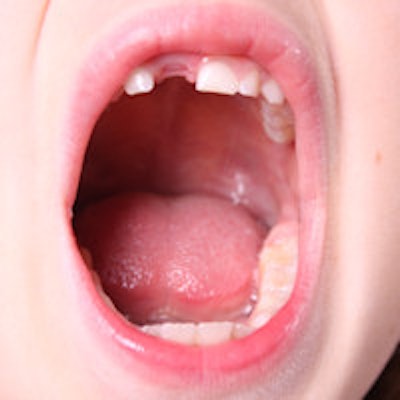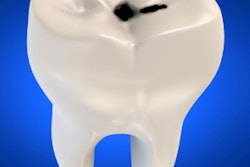
Most U.S. states are failing to make significant strides in school-based dental sealant programs, according to a new report by the Pew Charitable Trusts. Dentists can help children in their state by urging state legislatures to do more for children in high-need schools.
The new report, "States Stalled on Dental Sealant Programs," is a follow-up to a 2013 Pew report that graded states' sealant programs for low-income children. In the past two years, only 12 states improved access to sealants, while seven states lost ground.
"Most [states] fail to reach even half of eight-year-olds with this preventive service," the report stated. "The majority of states continue to lack sealant programs in most of their 'high-need' schools, which most states define as at least half of the students participate in the National School Lunch Program."
Dentists can take certain steps to help more children in their states receive sealants. Jane Koppelman, director of research at the Children's Dental Campaign at the Pew Charitable Trusts, said that dentists can make a positive change by seeing kids referred by hygienists who need more complex care and urging state legislatures to do more for kids in need.
States aren't reaching enough high-need schools
Dental sealants are important because they are an effective caries-prevention strategy and they cost two-thirds less than a filling, according to the report. They are especially important for low-income children, whose rates of tooth decay are higher and access to dental care is lower than their higher-income peers.
Pew regraded the 50 states and District of Columbia on four benchmarks, just as in 2013:
- Availability of sealant programs in high-need schools
- Ability of hygienists to place sealants without a prior exam by a dentist
- Collection of data and participation in a national database by states
- The proportion of students receiving sealants in the states, with the objective of meeting the federal Healthy People 2010 goal of applying sealant to permanent molars in at least half of 8-year-olds
Five states earned an A or A- grade, and three states plus the District of Columbia received F's. Most states (65%) fell somewhere in the lower middle, earning a C or D grade. Only Maine, New Hampshire, and Oregon earned the maximum possible points.
 Overall state grades from the 2015 "States Stalled on Dental Sealant Programs" report. Image courtesy of the Pew Charitable Trusts.
Overall state grades from the 2015 "States Stalled on Dental Sealant Programs" report. Image courtesy of the Pew Charitable Trusts. Overall state grades from the 2013 "Falling Short: Most States Lag on Dental Sealants" report. Image courtesy of the Pew Center on the States, 2012.
Overall state grades from the 2013 "Falling Short: Most States Lag on Dental Sealants" report. Image courtesy of the Pew Center on the States, 2012.Other notable findings include the following:
- Missouri and Wyoming had no sealant programs for high-need schools.
- 82% of states failed to reach even half of high-need schools.
- Only 13 states met the federal Healthy People 2010 goal of applying sealant to permanent molars of at least half each state's 8-year-olds.
- Most states (19) earned a C grade.
Room for improvement
Many states received the same or a similar grade to the 2013 report, but some have dropped dramatically. Seven states' grades slid by a full letter grade or more since the 2013 report.
Other states have made significant progress in the past two years. For instance, Montana improved two full letter grades from an F grade to a C. However, the report noted that a good grade is not a reason to stop making progress.
"This 'report card' deals exclusively with state performance on sealants. Because additional factors affect oral health ... even those policymakers in the states that earned A's and B's should review their progress on all policies that can make a difference," the report authors concluded.
| States that have improved or slipped a full letter grade or more from 2013 | ||||||
| State | 2013 report (data from 2012) | 2015 report (data from 2014) | % of high-need schools with sealant programs | Restricting hygientists | Collecting, submitting data | Met Healthy People 2010 sealant goal? |
| Alaska | A | B- | > 75% | Some restrictions | Yes, and submitted recent data | No |
| Connecticut | B | C | < 25% | No restrictions | Yes, and submitted recent data | No |
| Idaho | B | A | 50% to 74% | No restrictions | Yes, and submitted recent data | Yes |
| Illinois | C | D | < 25% | Severe restrictions | Yes, and submitted data | No |
| Iowa | C | B | 50% to 74% | Some restrictions | Yes, and submitted recent data | No |
| Massachusetts | B | C | 25% to 49% | Some restrictions | Yes, but no recent data | No |
| Montana | F | C | 25% to 49% | Some restrictions | Yes, but no recent data | No |
| North Carolina | F | D | 25% to 49% | Severe restrictions | Yes, and submitted data | No |
| North Dakota | A | B | < 25% | No restrictions | Yes, and submitted recent data | No |
| Ohio | C | B | 50% to 74% | Some restrictions | Yes, and submitted data | Yes |
| Rhode Island | C | D | 25% to 49% | Severe restrictions | Yes, and submitted recent data | No |
| Utah | C | D | 25% to 49% | Severe restrictions | Yes, and submitted recent data | No |
3 ways to help remove barriers to care
Besides placing sealants on children in their own practices, dentists can help improve access to sealants for children in other ways. For example, some states require a dentist and hygienist to enter a collaborative agreement in which the dentist allows the hygienist to place sealants in schools.
"It would be great if more dentists participate in these collaborative agreements, because we know they're underutilized," Koppelman told DrBicuspid.com. "It would also be great [for dentists] to see children who are referred by hygienists in the school program who need more complex care."
Koppelman also stressed one of the biggest barriers to school-based sealant programs is the prior exam rule that requires children to have a dental exam before receiving sealants. A prior exam law is currently in place in 13 states and the District of Columbia.
"We'd like to see this law removed in the 13 remaining states that have it," she said. "That's paramount, because that's really crippling the ability of hygienists to work in schools."
Another obstacle to school-based sealant programs is the Medicaid payment policy that does not allow hygienists to bill for sealants provided in schools, according the report. Thirteen states reported specific challenges other than a prior exam law that provided a barrier to sealant program implementation.
Dentists can take political action to change prior exam and Medicaid payment policies by contacting their dental societies and state legislature, according to Koppelman.



















